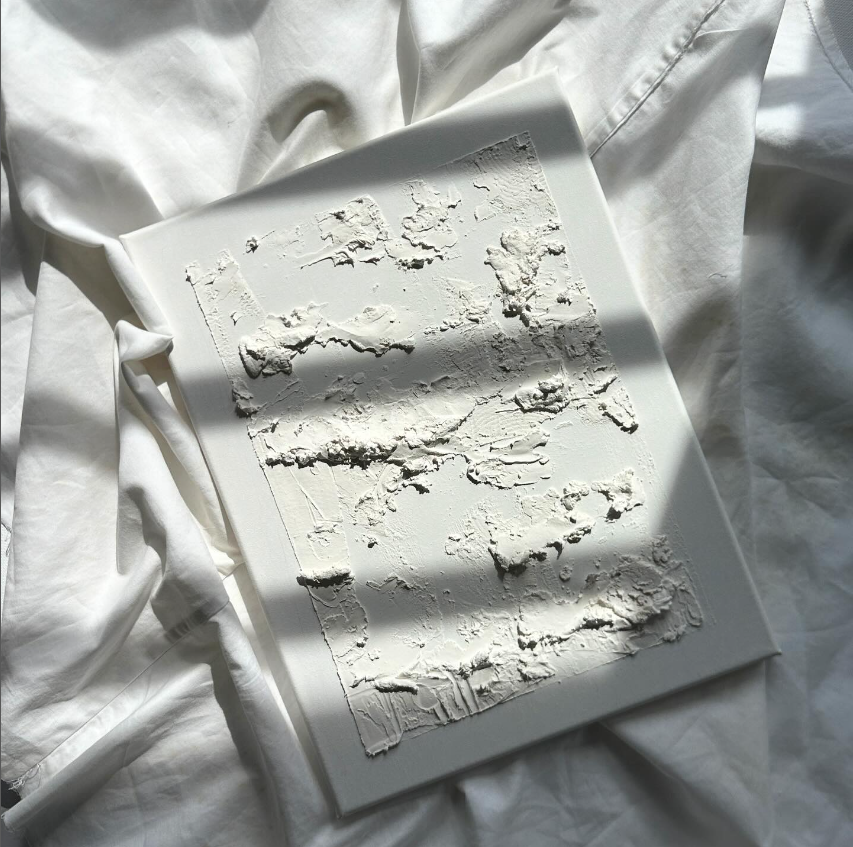AKMAL AZIZI
Pure, Minimal and Personal; Read about Akmal Azizi and his transition from 3D art into the world of Textural Art.
Akmal was one of the first artists to feature on Freaks & Weirdos back in 2021 when he was under the alias Flower Vomitt. At this time, Akmal primarily used 3D art using the human anatomy, un-natural environments and botanical elements to create a lot of surreal, psychedelic pieces. These are still available on his Instagram for you to see.
What made you switch from 3D art to textured art?
"During our previous discussion, I highlighted my enduring passion for the exploration of various artistic styles and mediums. This ongoing journey of discovering art as a holistic experience has led me to stumble upon the realm of minimal art, specifically textured art, which has proven to be remarkably refreshing.
As a dedicated practitioner of minimalism in my daily life, I've found a captivating allure in textured art. What initially appears as a blank canvas unfolds into an intricate tapestry upon closer examination. The interplay of lines, curves, rough textures, and glossy finishes creates a fascinating visual symphony. However, what elevates the fascination is the profound meaning embedded in this seemingly blank space.
Textured art, with its cryptic and mysterious aura, resonates with the depths of my own persona. Much like the art itself, there's a spiritual dimension to its meaning. It beckons one to a level of contemplation where the only way to truly grasp its existence is to devote one's complete attention and engage all the senses. It's an experience that transcends the visual, truly breath-taking in its ability to evoke a sense of wonder and connection to the profound mysteries of art and self."
There’s a lot of white used in your artwork; why do you use this colour in particular?
"It’s part of the artwork. It’s minimalism."
Do you plan on expanding into more colour or do you feel connected you the purity of white?
“Art knows no bounds. I would love to. Exploring color experimentation is enjoyable, and I'm eager to delve further into that realm within a new artistic style. ”
Unfortunately I lost the original website with that interview on it, however, since our last interaction; Akmal has gone through quite a significant artistic transition; now creating abstract, textured art and so naturally, I was curious to know more about his journey into this new found way of his self expression.
I love your piece ‘FRUSTRATION’ how did it come into fruition?
"Originally conceived as a complex abstract piece meant to portray Billie Eilish adorned in her Met Gala dress, my artistic endeavour, titled FRUSTRATION, underwent an unforeseen transformation into a chaotic expression when the intricate threads of my personal life became entwined with the creative process.”
“Amid this transformation, my struggle with anxiety and depression cast its shadow, infusing the artwork with the emotional nuances of mental health, creating a layered narrative that transcends the initial intent of a mere portrait.”
“The color choices deliberately embrace a stark contrast, employing bold strokes of black oil paint on a pristine white canvas. This intentional juxtaposition captures the essence of the chaos within, as the deep, expressive blacks mingle with the purity of white, creating a visual symphony that mirrors the intricate dance between frustration, personal turmoil, and the underlying theme of my mental health."
What do you like more about making textured art instead of 3D Art?
“Textured art resonates with my calm and modern sensibilities, featuring an intriguing interplay of curves and edges, simplicity within complexity. While some might find it unusual, it's precisely this uniqueness that captivates me, offering an insightful and enriching artistic experience. It visually mirrors my internal serenity and aligns with my appreciation for contemporary aesthetics.”
Is there anything in Malaysia that has influenced the way you make your new found style in art?
“Nope. Just unapologetically myself.”
Is there anything you are looking to physically incorporate into you art more?
“Flowers. I’ve always liked flowers and I would like to incorporate them into my new pieces.
Throughout my artistic journey, I've consistently engaged in color experimentation. However, the ongoing quest involves deciphering how to seamlessly incorporate these experiments into my tangible artworks. Despite my prior efforts, I have yet to discover a style that authentically connects with my inner self. While it may be facile for me to paint flowers and call it a day, my aspiration is to craft something more profound, resonating with the intricacies of my energy. The visual, sensory, and symbolic dimensions all come into play in this quest for artistic expression. Understanding this intricate interplay might elude some, and I don’t blame them; not everyone can be an artist let alone understand them.”
I can see from your tour video that there is a lot more that goes into creating these textured pieces such as going to pick the paint colours, getting the canvas etc; What has been the biggest challenge moving from 3D to a more physically intensive art?
“It comes with a hefty price tag. Creating physical art demands a financial investment for each piece, an aspect I find unappealing. When I reflect on my digital artworks, they consistently seem more accessible and less financially demanding.
Moreover, the expenses associated with physical art, including materials and canvases, often feel burdensome. This financial aspect becomes a constant consideration in my creative process, leading me to appreciate the cost-effectiveness and convenience that digital art provides. While the tactile experience of traditional mediums has its merits, the financial barrier makes me consistently lean towards the affordability and ease of digital creation.”



